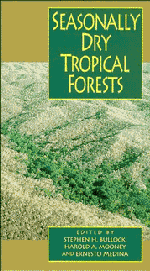Book contents
- Frontmatter
- Contents
- List of contributors
- Acknowledgements
- 1 Introduction
- 2 Dry forests of Central America and the Caribbean
- 3 Overview of the Brazilian caatinga
- 4 Savannas, woodlands and dry forests in Africa
- 5 Dry forest ecosystems of Thailand
- 6 The Cenozoic record of tropical dry forest in northern Latin America and the southern United States
- 7 Diversity and floristic composition of neotropical dry forests
- 8 Vertebrate diversity, ecology and conservation in neotropical dry forests
- 9 Diversity of life forms of higher plants in neotropical dry forests
- 10 Drought responses of neotropical dry forest trees
- 11 Plant reproduction in neotropical dry forests
- 12 Plant–herbivore interactions in Mesoamerican tropical dry forests
- 13 Biomass distribution and primary productivity of tropical dry forests
- 14 Nutrient cycling in tropical deciduous forests
- 15 Biology of the belowground system of tropical dry forests
- 16 Nitrogen trace gas emissions in a tropical dry forest ecosystem
- 17 Conversion of tropical dry forest to pasture and agriculture
- 18 Ethnobotany of the Mexican tropical dry forests
- Index
7 - Diversity and floristic composition of neotropical dry forests
Published online by Cambridge University Press: 07 September 2010
- Frontmatter
- Contents
- List of contributors
- Acknowledgements
- 1 Introduction
- 2 Dry forests of Central America and the Caribbean
- 3 Overview of the Brazilian caatinga
- 4 Savannas, woodlands and dry forests in Africa
- 5 Dry forest ecosystems of Thailand
- 6 The Cenozoic record of tropical dry forest in northern Latin America and the southern United States
- 7 Diversity and floristic composition of neotropical dry forests
- 8 Vertebrate diversity, ecology and conservation in neotropical dry forests
- 9 Diversity of life forms of higher plants in neotropical dry forests
- 10 Drought responses of neotropical dry forest trees
- 11 Plant reproduction in neotropical dry forests
- 12 Plant–herbivore interactions in Mesoamerican tropical dry forests
- 13 Biomass distribution and primary productivity of tropical dry forests
- 14 Nutrient cycling in tropical deciduous forests
- 15 Biology of the belowground system of tropical dry forests
- 16 Nitrogen trace gas emissions in a tropical dry forest ecosystem
- 17 Conversion of tropical dry forest to pasture and agriculture
- 18 Ethnobotany of the Mexican tropical dry forests
- Index
Summary
Introduction
Many studies of neotropical dry forest have tended to treat them in a very broad context, typically focusing on how they relate to or are different from moist or wet forests (e.g. Holdridge et al., 1971; Rzedowski, 1978; Gentry, 1982a, 1988; Hartshorn, 1983). Others have taken them as a relatively tractable surrogate for the more diverse moist or wet forests (e.g. Janzen, 1983, 1984, 1988; Hubbell, 1979) where taxonomy often poses severe limitations for the resolution of biologically interesting questions. Other authors have concentrated on the interesting physiological adaptations of dry forest organisms to seasonal water stress (e.g. Medina, Chapter 9; Holbrook, Whitbeck & Mooney, Chapter 10 and included references) or on various aspects of nutrient flow and biomass (e.g. Lugo et al. 1978; Murphy & Lugo 1986a, b). In addition there have been floristic and community ecological studies of individual dry forests (e.g. Troth, 1979; Valverde et al., 1979; Thien et al., 1982; Hartshorn, 1983; Heybrock, 1984; Lott, Bullock & Solís, 1987; Kelly et al, 1988; Rico-Gray et al., 1988; Arriaga & León, 1989; Cuadros, 1990; Saldias, 1991; Dodson & Gentry, 1992; see also summaries for México in Rzedowski, 1991a, b, and for the chaco in Prado, 1993). However, there have been remarkably few attempts to focus on the distinctive floristic composition of dry forests as a whole or on how different dry forest plant communities differ from each other.
- Type
- Chapter
- Information
- Seasonally Dry Tropical Forests , pp. 146 - 194Publisher: Cambridge University PressPrint publication year: 1995
- 244
- Cited by



